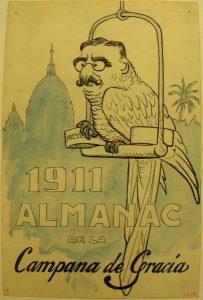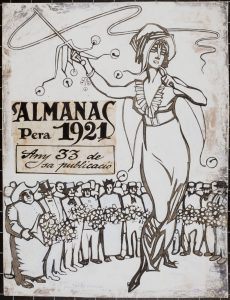Adela Laborda and Francesc Quílez
With regard to the thematic content, the majority of the works in the Agell Collection reflect the main historical events of the period stretching from the 1880s to the proclamation of the Second Republic (1931). In so turbulent a political context, it is natural that draughtsmen should have acted as notaries of current events and depicted the most outstanding ones. The images conserved can be grouped into three different centres of interest, based on the international and colonial wars (the First World War and the Spanish colonial wars in Morocco and Cuba), and they include political criticism, alluding to the regime of the Bourbon Restoration, with the depiction of a large number of its protagonists: Antonio Maura, Francesc Cambó, José Canalejas, made to look like figures in a puppet theatre show, in which their main defects were ridiculed and caricatured with scathing, caustic humour. The erratic decisions of the leaders of a regime in the process of falling apart gave rise to very painful consequences for the poor working class, the victims of hunger and the rise in the cost of living, among other things. Generally speaking, the anticlerical and antimonarchic bias of the two publications for which this body of graphic work was produced, defined their character and became one of their distinctive traits.

There are also a large number of illustrations showing the customs and morals of the day that help to inform and document that society’s system of values and their hierarchization. They are actually a wide range of social, cultural and historical motifs that take on a visual form and enable us to understand the concerns and interests of both the protagonists and their actors. In this respect, some of the productions, especially the covers of the Almanac de la Campana de Gràcia and L’Esquella de la Torratxa, deviate from the aforementioned types and become expressions of a model of a more aesthetic nature. The artists usually took more care with their drawings and in formal and technical terms they endeavoured to create more studied compositions, forgoing the rapid and agile line that characterizes the drawings that illustrate a text or a cartoon.
With regard to the artists included in the collection, it may be said that it is a group of the most conspicuous representatives of Catalan graphic humour, except for two major absences: Josep Lluís Pellicer and Apel·les Mestres, by whom, surprisingly, there is no work conserved in the collection despite their being regular contributors to both publications. Notwithstanding that, this is a group of drawings representative of the work of more than 500 artists, a fact that reinforces the image of a diverse collection. This enables us to study, extensively and intensively, the work of the most qualified Catalan humorous graphic artists of the last third of the nineteenth and the first third of the twentieth century.

The variety can also be seen in the existence of different generational groups, from the oldest, represented by Manuel Moliné Muns (Barcelona, 1833-1901), a versatile, multi-faceted creator, who besides drawing was also inclined to paint, and who, above all, became one of the earliest exponents of photography in Catalonia. In this respect, Moliné, the creator a group of 181 works, exemplifies a characteristic shared by all the draughtsmen, the need to work on a thousand and one things, to accept any and all kinds of work and to adapt to a very unstable market that precluded specialization.
At the other end of the timeline, we find the names of Rafael Barradas and Juan Gris, two artists who later became representatives of Avant-garde modernity. By the former, seven works have survived, and by the latter, just five, one of which is an inside cover of the Almanac de L’Esquella de la Torratxa per a 1921. The group is headed by the work of Josep Costa Ferrer, who has more than 5,600 compositions in the collection. After him, trailing a long way behind in second place we have Ramon Miró (Reus, 1864 – Barcelona, 1927), with 903 works.

As well as all the artists mentioned so far, some of the most outstanding and renowned figures in the history of Catalan drawing are also present. Among them, we can mention the names of Llorenç Brunet and Jaume Passarell (Badalona, 1889 – Barcelona, 1975), represented with 167 and 79 productions, respectively, and also Romà Bonet, Bon, (Barcelona, 1886-1967) and Gaietà Cornet (Barcelona, 1878-1945), with 146 and 138 works, respectively.

Among the Modernista illustrators, there is one of the great names, the draughtsman from Tarragona Ricard Opisso, represented with 179 works. Although with far fewer works, nine and seven, respectively, we should also mention the presence of two draughtsmen, Joan Cardona (Barcelona, 1877-1957) and Eveli Torent (Badalona, 1876 – Barcelona, 1940), both of whom, despite having had a great reputation in the Modernista artistic context – the latter especially – have not received the recognition they deserve.

Ricard Opisso, Our Rich (076865-D), L’Esquella de la Torratxa, 16/5/1924, 2358, p. 293 
Eveli Torent, The Neurotic Woman’s Afternoons (085058-D), 1904. Almanac de L’Esquella de la Torratxa, 1905, p. 185
The collection also has a remarkable volume of work by one of the most conspicuous illustrators of the genre, an artist gifted with excellent technical skills, capable of doing paintings and drawings equally skilfully. With a group of 260 works, the magnificent work and the biting irony of Feliu Elias are very well represented. In this case, the repertoire clearly shows a change of thematic register, as it includes both social events, transplanted from the lived reality, and a particular interest in caricaturing modern artistic practice, producing a sarcastic view that reveals an intransigent attitude towards all the movements that veered away from the realist figurative canon. By his brother, Lluís Elias, Anem, (Sabadell, 1896-1953), much less well known, there are 88 works.

The majority of these artists were born in Catalonia, except for a few who came from other parts of Spain, as in the case of Ramiro Mondragón del Río, from Aragon (Híjar, second half of the 19th century – France, first half of the 20th century), with more than 424 works; José Blanco Coris (Malaga, 1862-1946), with 205 works, and his fellow Andalusian Rafael Latorre (Granada, 1872-1960), with 10 works; and from Valencia, the notable illustrators and outstanding poster-makers Pasqual Capuz (Valencia, 1882 – Barcelona, 1959) and Josep Segrelles, with 54 and 18 works, respectively.

Finally, even though is it a very anecdotal phenomenon, we have to refer to the level of incidence of foreign artists, which is far lower. In fact, the only ones we can mention are the Frenchman Henri-Gabriel Ibels (Paris, 1867-1936), who was a big influence on Catalan art in the late nineteenth century, and the Italian Aleardo Villa (Ravello, 1865 – Milan, 1906), well known for having been and important poster-maker and for his participation in the poster competition held by the ‘Cigarrillos París’ brand of cigarettes, in which he won first prize.

In the absence of a more in-depth study to enable us to learn more about a very remarkable collection, we believe that this research has made it possible to reconstruct some of the principal constituent episodes and it has also helped to raise the profile of a collection that is not very well known, not just by the general public, but by art experts too.
From this point of view, we consider that this study has laid the foundations of an immediate task that ought to serve to highlight an essential collection in order to learn more about the history of illustration and to enhance a patrimonial asset that enriches the collections of the Cabinet of Drawings and Prints. To achieve this goal, which ought to culminate with the dissemination of the entire collection, we must make an effort to improve the current documentation of the works, study them, photograph them, digitize them and make them available to everyone.
We wish to dedicate this blog to the Agell family for very kindly attending to our consultations.
Related links
Collectors that have made museums
Francesc Quílez
and
Gabinet de Dibuixos i Gravats







